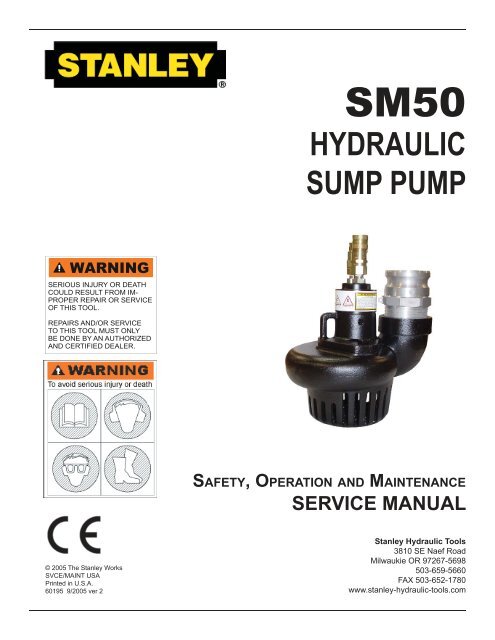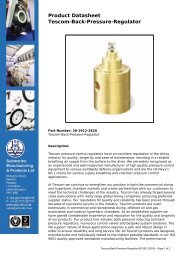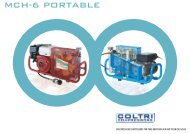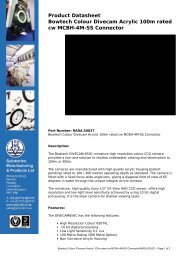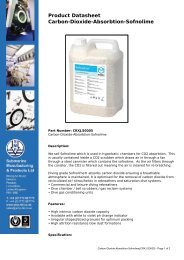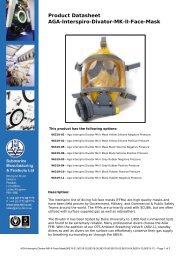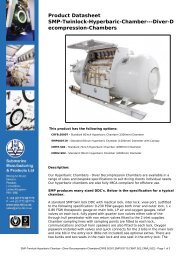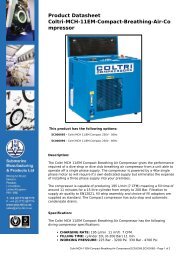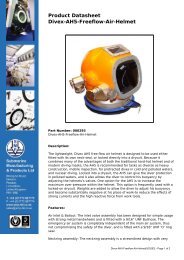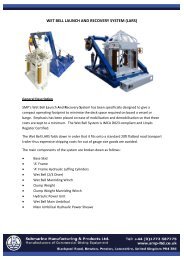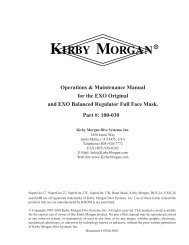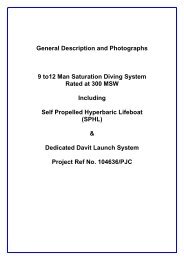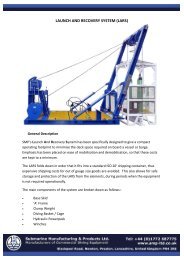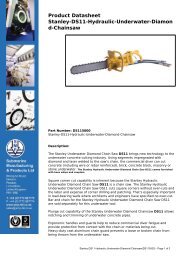SM50 Sump Pump Operators Manual - Submarine Manufacturing ...
SM50 Sump Pump Operators Manual - Submarine Manufacturing ...
SM50 Sump Pump Operators Manual - Submarine Manufacturing ...
- No tags were found...
Create successful ePaper yourself
Turn your PDF publications into a flip-book with our unique Google optimized e-Paper software.
<strong>SM50</strong>HYDRAULICSUMP PUMPWARNINGSAFETY, OPERATION AND MAINTENANCESERVICE MANUAL© 2005 The Stanley WorksSVCE/MAINT USAPrinted in U.S.A.60195 9/2005 ver 2Stanley Hydraulic Tools3810 SE Naef RoadMilwaukie OR 97267-5698503-659-5660FAX 503-652-1780www.stanley-hydraulic-tools.com
TABLE OF CONTENTSCERTIFICATE OF CONFORMITY ................................................................................................4SAFETY SYMBOLS ......................................................................................................................5SAFETY PRECAUTIONS .............................................................................................................6TOOL STICKERS & TAGS ............................................................................................................8HYDRAULIC HOSE REQUIREMENTS ........................................................................................9HTMA REQUIREMENTS ............................................................................................................10OPERATION ...............................................................................................................................11PREOPERATION PROCEDURES ..............................................................................................11CHECK POWER SOURCE .........................................................................................................11CONNECT HOSES .....................................................................................................................11PUMP OPERATION ....................................................................................................................11COLD WEATHER OPERATION ..................................................................................................11MAINTENANCE ..........................................................................................................................12CLEANING THE PUMPING CHAMBER .....................................................................................12EQUIPMENT PROTECTION & CARE ........................................................................................13TROUBLESHOOTING ................................................................................................................14SPECIFICATIONS .......................................................................................................................15ACCESSORIES ..........................................................................................................................15SERVICE .....................................................................................................................................16PARTS ILLUSTRATION ..............................................................................................................19PARTS LIST ................................................................................................................................20WARRANTY ................................................................................................................................21SERVICING THE STANLEY HYDRAULIC <strong>Sump</strong> <strong>Pump</strong>. This manual contains safety, operation, and routinemaintenance instructions. Stanley Hydraulic Tools recommends that servicing of hydraulic tools, otherthan routine maintenance, be performed by an authorized and certified dealer. Please read the followingwarning.WARNINGSERIOUS INJURY OR DEATH COULD RESULT FROM THE IM-PROPER REPAIR OR SERVICE OF THIS TOOL.REPAIRS AND / OR SERVICE TO THIS TOOL MUST ONLY BEDONE BY AN AUTHORIZED AND CERTIFIED DEALER.For the nearest authorized and certified dealer, call Stanley Hydraulic Tools at the number listed on theback of this manual and ask for a Customer Service Representative.3
CERTIFICATE OF CONFORMITYCERTIFICATE OF CONFORMITYÜBEREINSTIMMUNGS-ZERTIFIKATCERTIFICAT DE CONFORMITE CEECERTIFICADO DE CONFORMIDADCERTIFICATO DI CONFORMITAHydraulic Tools______________________________________________________________________I, the undersigned:Ich, der Unterzeichnende:Je soussigné:El abajo firmante:lo sottoscritto:Winterling, DavidSurname and First names/Familiennname und Vornamen/Nom et prénom/Nombre y apellido/Cognome e nomehereby certify that the construction plant or equipment specified hereunder:bestätige hiermit, daß das im folgenden genannten Werk oder Gerät:certifies par ceci que l’ usine ou l’ équipement de construction indiqué cidessous:por el presente certifico que la fabrica o el equipo especificado a continuacion:certifico che l’impianto o l’attrezzatura sotto specificata:1. Category: Submersible <strong>Pump</strong>Kategorie:Catégorie:Categoria:Categoria:2. Make/Ausführung/Marque/Marca/Marca Stanley3. Type/Typ/Type/Tipo/Tipo: <strong>SM50</strong>1004. Serial number of equipment:Seriennummer des Geräts:Numéro de série de l’équipement:Numero de serie del equipo:AllMatricola dell´attrezzatura:5. Year of manufacture/Baujahr/année de fabrication/Año de fabricacion/Anno di fabbricazione 2002Has been manufactured in conformity with - EEC Type examination as shown.Wurde hergestellt in Übereinstimmung mit - EEC Typ-Prüfung nach.Est fabriqué conformément - au(x) type(s) examiné(s) comme indiqué dans le tableau ci-après.Ha sido fabricado de acuerdo con - tipo examen EEC como dice.E’ stata costruita in conformitá con - le norme CEE come illustrato.DirectiveRichtlinieDirectives particulièresDirectrizDirettivaExamen CEE de typeNo.NrNuméroNon.DateDatumDateFechaDataApproved bodyPrüfung durchOrganisme agrééAprobadoCollaudatoDate of expiryAblaufdatumDate d´expirationFecha de caducidadData di scadenzaENMachinery Directive80998/37/EC19951998SelfSelfNANA6. Special Provisions: NoneSpezielle Bestimmungen:Dispositions particulières:Provisiones especiales:Disposizioni speciali:Done at/Ort/Fait à/Dado en/Fatto a Stanley Hydraulic Tools, Milwaukie, Oregon USA Date/Datum/le/Fecha/Data 2002Signature/Unterschrift/Signature/Firma/Firma____________________________________________________________________________Position/Position/Fonction/Puesto/PosizioneEngineering Manager4
SAFETY SYMBOLSSafety symbols and signal words, as shown below, are used to emphasize all operator, maintenance and repairactions which, if not strictly followed, could result in a life-threatening situation, bodily injury or damage to equipment.This is the safety alert symbol. It is used to alert you to potential personalinjury hazards. Obey all safety messages that follow this symbol to avoidpossible injury or death.DANGERThis safety alert and signal word indicate an imminently hazardous situationwhich, if not avoided, will result in death or serious injury.WARNINGThis safety alert and signal word indicate a potentially hazardous situationwhich, if not avoided, could result in death or serious injury.CAUTIONThis safety alert and signal word indicate a potentially hazardous situationwhich, if not avoided, may result in minor or moderate injury.This signal word indicates a potentially hazardous situation which, if notavoided, may result in property damage.NOTICEThis signal word indicates a situation which, if not avoided, will result indamage to the equipment.IMPORTANTThis signal word indicates a situation which, if not avoided, may result indamage to the equipment.Always observe safety symbols. They are included for your safety and for the protection of the tool.LOCAL SAFETY REGULATIONSEnter any local safety regulations here. Keep these instructions in an area accessible to the operator and maintenancepersonnel.5
SAFETY PRECAUTIONSTool operators and maintenance personnel must always comply with the safetyprecautions given in this manual and on the stickers and tags attached to the tooland hose.These safety precautions are given for your safety. Review them carefully beforeoperating the tool and before performing general maintenance or repairs.Supervising personnel should develop additional precautions relating to the specifi cwork area and local safety regulations. If so, place the added precautions in thespace provided in this manual.The models <strong>SM50</strong> Hydraulic <strong>Pump</strong> will provide safe and dependable service if operatedin accordance with the instructions given in this manual. Read and understandthis manual and any stickers and tags attached to the pump and hoses beforeoperation. Failure to do so could result in personal injury or equipment damage.• Operator must start in a work area without bystanders. The operator must be familiar with all prohibited work areassuch as excessive slopes and dangerous terrain conditions.• Establish a training program for all operators to ensure safe operations.• Do not operate the tool unless thoroughly trained or under the supervision of an instructor.• Always wear safety equipment such as goggles, head protection, and safety shoes at all times when operatingthe tool.• Do not inspect or clean the tool while the hydraulic power source is connected. Accidental engagement of thetool can cause serious injury.• Do not operate this tool without fi rst reading the Operating Instructions.• Do not install or remove this tool while the hydraulic power source is connected. Accidental engagement ofthe tool can cause serious injury.• Never operate the tool near energized transmission lines. know the location of buried or covered services before startingwork.• Do not wear loose fi tting clothing when operating the tool. Loose fi tting clothing can get entangled with thetool and cause serious injury.• Supply hoses must have a minimum working pressure rating of 2500 psi/175 bar.• Be sure all hose connections are tight.• The hydraulic circuit control valve must be in the “OFF” position when coupling or uncoupling the tool. Wipe all couplersclean before connecting. Failure to do so may result in damage to the quick couplers and causeoverheating. Use only lint-free cloths.• Do not operate the tool at oil temperatures above 140° F/60° C. Operation at higher oil temperatures cancause operator discomfort and may cause damage to the tool.• Do not operate a damaged, improperly adjusted, or incompletely assembled tool.6
SAFETY PRECAUTIONS• To avoid personal injury or equipment damage, all tool repair, maintenance and service must only beperformed by authorized and properly trained personnel.• Do not exceed the rated limits of the tool or use the tool for applications beyond its design capacity.• Always keep critical tool markings, such as labels and warning stickers legible.• Always replace parts with replacement parts recommended by Stanley Hydraulic Tools.• Check fastener tightness often and before each use daily.7
HTMA REQUIREMENTSTOOL CATEGORYHYDRAULIC SYSTEMREQUIREMENTS TYPE 1 TYPE II TYPE III TYPE RRFLOW RATETOOL OPERATING PRESSURE(at the power supply outlet)SYSTEM RELIEF VALVE SETTING(at the power supply outlet)MAXIMUM BACK PRESSURE(at tool end of the return hose)Measured at a max. fl uid viscosity of:(at min. operating temperature)TEMPERATURESuffi cient heat rejection capacityto limit max. fl uid temperature to:(at max. expected ambient temperature)4-6 gpm 7-9 gpm 11-13 gpm 9-10.5 gpm(15-23 lpm) (26-34 lpm) (42-49 lpm) (34-40 lpm)2000 psi 2000 psi 2000 psi 2000 psi(138 bar) (138 bar) (138 bar) (138 bar)2100-2250 psi 2100-2250 psi 2100-2250 psi 2200-2300 psi(145-155 bar) (145-155 bar) (145-155 bar) (152-159 bar)250 psi 250 psi 250 psi 250 psi(17 bar) (17 bar) (17 bar) (17 bar)400 ssu* 400 ssu* 400 ssu* 400 ssu*(82 centistokes) (82 centistokes) (82 centistokes) (82 centistokes)140° F 140° F 140° F 140° F(60° C) (60° C) (60° C) (60° C)Min. cooling capacityat a temperature difference ofbetween ambient and fl uid tempsNOTE:Do not operate the tool at oil temperatures above 140° F (60° C). Operation at higher temperatures can cause operatordiscomfort at the tool.FILTERMin. full-fl ow fi ltrationSized for fl ow of at least:(For cold temp. startup and max. dirt-holding capacity)3 hp 5 hp 7 hp 6 hp(2.24 kW) (3.73 kW) (4.47 kW) (5.22 kW)40° F 40° F 40° F 40° F(22° C) (22° C) (22° C) (22° C)25 microns 25 microns 25 microns 25 microns30 gpm 30 gpm 30 gpm 30 gpm(114 lpm) (114 lpm) (114 lpm) (114 lpm)HYDRAULIC FLUIDPetroleum based(premium grade, anti-wear, non-conductive)VISCOSITY(at min. and max. operating temps)100-400 ssu* 100-400 ssu* 100-400 ssu* 100-400 ssu*(20-82 centistokes)NOTE:When choosing hydraulic fl uid, the expected oil temperature extremes that will be experienced in service determine themost suitable temperature viscosity characteristics. Hydraulic fl uids with a viscosity index over 140 will meet the requirementsover a wide range of operating temperatures.*SSU = Saybolt Seconds UniversalNOTE:These are general hydraulic system requirements. See tool Specifi cation page for tool specifi c requirements.10
OPERATIONPREOPERATION PROCEDURESCHECK POWER SOURCE1. Using a calibrated fl ow meter and pres sure gauge, makesure the hydraulic power source develops a fl ow of 7-12gpm/26-45 Ipm at 1000-2000 psi/70-140 bar.2. Make certain that the power source is equipped with arelief valve set to open at 2100 psi/145 bar maximum.3. Make certain that the power source re turn pressure doesnot exceed 250 psi/17 bar.4. Make sure the trash pump inlet is clear of debris. Removeany obstruction before operating. Refer to PUMPCLEANING PROCEDURES.CONNECT HOSES1. Wipe all hose couplers with a clean lint free cloth beforemaking connections.2. Connect the hoses from the hydraulic power source tothe couplers on the trash pump or trash pump hoses. It is agood practice to connect return hose fi rst and disconnect itlast to minimize or avoid trapped pressure within the trashpump motor.Note:If uncoupled hoses are left in the sun, pressure increaseinside the hoses might make them difficult toconnect. Whenever possible, connectthe free ends ofthe hoses together.3. Observe the arrow on the couplers to ensure that thefl ow is in the proper direc tion. The female coupler on thetrash pump is the inlet (pressure) coupler.PUMP OPERATION1. Observe all safety precautions.Note:The <strong>SM50</strong> is not desgined for use with a suction pipeinlet. The diameter of the suction screen at the bottomof the pump provides madimum pump efficiency.Reducing the size of this inlet will greatly reduce pumpperformance.2. Connect a hose fi tted with a 3 inch/76.2 mm female camlockcoupler to the pump outlet fi tting. Make sure the fi ttingis securely tightened. For best performance, keep the hoseas short as possible and lay it out to avoid sharp bends orkinks.3. Lower the pump into the liquid to be pumped. Locate theoutlet end of the discharge hose to disperse the liquid asrequired. Remove any kinks from thehose to assure maximumwater fl ow.IMPORTANTNever point the hose at bystanders.4. Turn on the hydraulic power source. Watch for solids inthe liquid being pumped. If solids are excessive, the dischargefl ow might decrease. If this happens, stop the pumpand check for the cause of the problem.Under some conditions, the liquid being pumped might beslowed enough so It can no longer push particles in theliquid. If this happens, particles can accumulate in the hoseand backup the pumping chamber, causing further restriction.The impeller then acts as a “grinding wheel whichcauses acceler ated pump wear. Reduced liquid fl ow can becaused by the following:• The pump sinks into solids at the bottom of the hole.• The end of the outlet hose is too high, causing an excessivelift height for the column of liquid being pushed by thetrash pump. This slows the fl ow of liquid to a level where itcan no longer carry solids out the end of the hose.• The fl ow and pressure of hydraulic fl uid to the pump istoo low, which re duces impeller speed. A 20% de crease inhydraulic fl uid fl ow can reduce pump performance by 50%.When operating at reduced hydraulic fl ow and pressure, theend of the outlet hose should not be more than 30 ft/9 mabove the liquid.5. When pumping is complete, set the hy draulic controlvalve to the “OFF” posi tion. Lift the pump from the workarea.COLD WEATHER OPERATIONIf the trash pump is to be used during cold weather, preheatthe hydraulic fl uid at low power source speed. When usingthe nor mally recommended fl uids, fl uid should be at orabove 50°FI1 DoC (400 ssu/82 centistokes) before use.Damage to the hydraulic system or pump motor seals canresult from use with fl uid that is too viscous or thick.11
MAINTENANCECLEANING THE PUMPINGCHAMBERDebris such as weeds, sand and other solids may becometrapped in the water hose and pumping chamber. This canreduce pump performance. It is important that the pumpingchamber be kept clean at all times. The chamber can becleaned as follows:1. Remove motor and impeller by removing the two M12 x1.75 Hex Head capscrews.2. Remove all debris from the pump screen.3. Thoroughly clean the volute and impeller. Do not removethe impeller unless necessary for repair or replacement orto remove trapped debris.4. Assemble the motor and impeller to the volute. Cleanthe capscrews and lubricate the threads with underwatergrease before installation.5. Remove all debris from the hose. Otherwise, solids willbackfi ll the pump.12
EQUIPMENT PROTECTION & CARENOTICEIn addition to the SafetyPrecautions in this manual,observe the following forequipment protection andcare.• Make sure all couplers are wiped clean before connection.• The hydraulic circuit control valve must be in the “OFF” position when coupling or uncouplinghydraulic tools. Failure to do so may result in damage to the quick couples and cause overheatingof the hydraulic system.• Always store the tool in a clean dry space, safe from damage or pilferage.• Make sure the circuit PRESSURE hose (with male quick disconnect) is connected to the “IN” port.The circuit RETURN hose (with female quick disconnect) is connected to the opposite port. Do notreverse circuit fl ow. This can cause damage to internal seals.• Always replace hoses, couplings and other parts with replacement parts recommended by StanleyHydraulic Tools. Supply hoses must have a minimum working pressure rating of 2500 psi/172 bar.• Do not exceed the rated fl ow (see Specifi cations) in this manual for correct fl ow rate andmodel number. Rapid failure of the internal seals may result.• Always keep critical tool markings, such as warning stickers and tags legible.• Do not use the tool for applications it was not designed for.• Tool repair should be performed by experienced personnel only.• Make certain that the recommended relief valves are installed in the pressure side of the system.• Do not use the tool for applications for which it was not intended.13
TROUBLESHOOTINGIf symptoms of poor performance develop, the following chart can be used as a guide to correct the problem.When diagnosing faults in operation, always make sure the hydraulic power source is supplying the correct hydraulic fl owand pressure as listed in the table. Use a fl owmeter know to be accurate. Check the fl ow with the hydraulic fl uid temperatureat least 80 o F/27 o C.PROBLEM CAUSE SOLUTION<strong>Pump</strong> will not start.Poor pump performance.Poor pump performance with excessivewear.No hydraulic fl uid fl ow or pressure.Defective couplers.Impeller jammed with debris.Impeller rubbing against wear plates.Defective hydraulic motor.Hydraulic fl ow reversed.Improper hydraulic fl uid fl ow.<strong>Pump</strong> submersed in sediment.Trash pump inlet restricted.Discharge hose kinked or restricted.Discharge hose too small.Water lift too high.Impeller worn or damaged.<strong>Pump</strong> not matched to applicationHose used on suction side of pump.Too many solids in the water. Water speedout of the hose may be too slow, thereofrehose and pump load up with solids.Turn on power unit and check that 7-12gpm/26-45 lpm at 1000-2000 psi/70-140bar is available at the pump.Check the couplers. Replace if necessary.Clean the pumping chamber as describedin the Maintenance section in this manual.Check and adjust the impeller clearanceas described in the Service Instructionssection in this manual.Repair or replace motor.Check that the hoses are correctly connectedto the pump motor ports. Thefemale coupler should be connected to the“IN” port. The return fl uid must never fl owthrough a reversing valve.Check that 7-12 gpm/26-45 lpm at 1000-2000 psi/70-140 bar is available at thetrash pump. A 20% decrease in fl ow canresult in a 50% decrease in pump performance.Lift the pump from the bottom of the holeor chamber. Use a fl at support under thepump if necessary.Remove suction screen and thoroughlyclean. Reassemble.Straighten the hose. If the hose must bendat the top of the hole, use a piece of splitrigid conduit with large diameter of theexpanded hose. This keeps the hose fromkinking.Use a 3-inch diameter fi re hose.Lower the outlet end of the dischargehose. Increase hydraulic fl ow (12 gpm/45lpm max).Check impeller for damage and excessivewear. Replace if necessary.Obtain higher capacity pump.Remove. Use no plumbing on suction sideof pump.Reduce solids content. Increase pumpspeed.14
SPECIFICATIONSCapacity ...................................................................................................................................................500 gpm/1890 lpmWeight ............................................................................................................................................................... 21 lbs/9.5 kgLength .......................................................................................................................................................... 10.5 in./26.7 cmWidth ............................................................................................................................................................... 10 in./25.4 cmPressure ....................................................................................................................................... 1000-2000 psi/70-140 barFlow Range ........................................................................................................................................... 7-12 gpm/26-45 lpmMaximum Flow ...............................................................................................................................................12 gpm/45 lpmPorting .............................................................................................................................................................-8SAE O-RingConnect Size and Type .................................................................................3/8 in. Flush Face Quick Disconnect CouplersDischarge Diameter ............................................................................................................................................. 3 in./7.6 cmSound Pressure ............................................................................................................................................
TOOL DISASSEMBLY /REASSEMBLYNote: For orientation of parts in the following procedures,refer to the parts drawing later in this manual.PRIOR TO DISASSEMBLY1. Clean the exterior of the tool and place on a clean worksurface.2. Obtain the seal kit listed on the PARTS LIST so all sealsexposed during disassembly can be replaced.PRIOR TO REASSEMBLY1. Clean all parts with a degreasing solution2. Blow dry all parts or use lint-free cloths.3. Ensure that all seals exposed during disassembly arereplaced with new parts.4. Apply clean grease or o-ring lubricant to all parts duringassembly.VOLUTETOOL DISASSEMBLY1. Remove the volute (1) by fi rst removing the hex headcap screws (25) and pulling the motor and impeller off thevolute.IMPELLER1. Remove hex socket head capscrew (3) and washer (4)before lifting impeller (5) off motor assembly.2. Remove key (18) and shim stack (7 & 8) from impeller.MOTOR CAP1. Remove the hex socket head capscrews (33) that securethe motor cap (31) to the front bearing housing (24) andremove the motor cap. Do not in any way excessively forcethe motor cap off the front bearing housing.2. Remove the o-ring (26) from the motor cap.SERVICEDRIVE SHAFT1. Remove idler gear (29), idler shaft (30), drive gear (28),and needle roller (19) from front bearing housing.2. Remove the v-ring (6) from the seal race (14) before pullingthe seal race off the drive shaft.3. Remove retaining ring (9).4. Using a pick, remove the seal carrier (10), cup seal (12),o-ring (11), seal retainer (13), and o-ring (15) from the bearingcavity.5. Press the drive shaft (17) and bearings (16) from thefront bearing housing.6. Spin the ball bearings on the drive shaft. The bearingshould turn smoothly. To replace the bearing, supportthe outer race and press down on the drive shaft from thethreaded end. Do not reuse the ball bearing once it hasbeen removed from the drive shaft.DRIVE SHAFT SEAL1. Remove the retaining ring (20), quad ring (21), sealgland (22) and o-ring (23) from the drive shaft bore using apick.CLEANING AND INSPECTIONCLEANINGClean all parts with a degreasing solution. Blow dry withcompressed air or use lint-free cloths.Gear Chamber (Motor Cap)The chamber bores and bottoms around the shaft bushingsshould be polished and not rough or grooved. If the bushingbores are yellow-bronze, replace them and investigatethe cause of wear.The fl at surfaces around the chamber and bolt holes shouldbe fl at and free of nicks or burrs that could cause misalignmentor leaks.BUSHINGSThe inside of the bushings should be gray with somebronze showing through. If signifi cant yellow-bronzeshows, replace the bushings. Inspect the motor shaft andidler shaft for corresponding wear and replace as required.16
SERVICEGEARSThe drive and idler gears should have straight tips withoutnicks, square tooth ends, and a smooth even polish on theteeth and end faces. Replace the gear if cracks are present.FRONT BEARING HOUSINGThe surface near the gears should show two interconnectingpolished circles without a step.SHAFTSThe shaft diameter at the bearing and seal locations mustbe smooth. Grooves, roughness or a reduced diameterindicate fl uid contamination or damaged bushings. Gritparticles may have been imbedded in the bushings, grindinginto the hardened shaft. If abnormal shaft wear asnoted above occurs (more than normal polishing), replaceboth the shaft and associated bushings.Also check the hydraulic system for excess contaminationin the fl uid and for fi lter condition. Operating conditionsmay require changing from a 25-micron fi lter to an oversized10-micron fi lter.DRIVE SHAFT SEALTOOL REASSEMBLY1. Heavily lubricate and install a new o-ring (23) and quadring (21) into seal gland (22). Ensure the quad ring is nottwisted during assembly.2. Install seal gland and attached parts into front bearinghousing and secure with retaining ring (20).DRIVE SHAFT1 Install bearings (16) onto lubricated drive shaft (17) bysupporting the inner races of the bearings and pressingdrive shaft through bearings until the bearings rest againstthe shoulder. Installation by the outer race will cause bearingdamage.2. Pack grease into needle roller groove on drive shaftand insert drive shaft into the seal gland. Using a bearingpusher or a sleeve / socket with a diameter slightly smallerthan the bearing bore, press the bearing assembly intoplace using the outer race. Installation by the inner racewill result in bearing damage.3. Lubricate and install o-ring (15) and seal race (14) ontodriveshaft.4. Lubricate and install seal retainer (13) and o-ring (11)into bearing bore.5. Heavily lubricate with underwater grease and install cupseal (12) and seal carrier (10) into bearing bore and securewith retaining ring (9). Installation of seal carrier and cupseal before seal race has been installed will result in damageto cup seal.6. Lubricate with underwater grease and install v-ring (6)onto seal race.7. Install idler shaft (30) and idler gear (29).8. Use grease to hold needle roller (19) in place beforeinstalling drive gear (28).MOTOR CAP1. Lubricate and install o-ring (26) into motor cap (31).2. Lubricate hex socket head capscrews (33) with anantiseize compound and install motor cap to front bearinghousing. Tighten capscrews to 8-10 ft.lb. Note the orientationof the motor cap as the bolt holes will only line up oneway.Do not force parts together.IMPELLERCAUTION1. Install shim stack (7&8) onto drive shaft.2. Install key (18) and impeller (5) to drive shaft and, usingloctite, secure with washer (4) and hex socket headcapscrew (3). Tighten capscrew to 15 ft.lb.3. Using a depth mic, measure the distance from thebottom of the motor fl ange to the bottom of the steppeddiameter as shown below. Adjust shim stack accordingly toachieve a 2.285 / 2.270 offset.17
SERVICEVOLUTE1. Assemble motor and impeller to volute (1) and securewith hex head cap screws (25).2. Use an allen wrench to ensure that the impeller with freewheelafter assembly.18
PARTS ILLUSTRATION3635191734331816151465132 MOTOR ASSEMBLYUSED ON SUMP PUMPSWITH SERIAL NUMBERS600 AND ABOVE, THIS MOTORCAN ONLY BE PURCHASEDAS AN ASSEMBLY. INDIVIDUALPARTS ARE NOT AVAILABLE.1331121110309628272987526252424323122212019
PARTS LISTItemNo.Part No. Qty Description1 52669 1 Volute2 52720 1 Camlock Coupling 3 in.3 13815 1 HSHCS 5/16 - 18 x 3/44 56763 1 Washer5 52671 1 Impeller6 52716 1 V-Ring7 31032 * Shim .0208 31033 * Shim .0109 00166 1 Retaining Ring10 52719 1 Seal Carrier11 01262 1 O-ring 1-3/4 x 1-7/8 x 1/16 -03112 58651 1 Cup Seal13 56658 1 Seal Retainer14 56697 1 Seal Race15 01211 1 O-ring 5/8 x 3/4 x 1/16 -01616 00148 2 Bearing17 52696 1 Drive Shaft18 00635 1 Key19 06881 1 Needle Roller20 00170 1 Retaining Ring21 00669 1 Quad Ring 1/2 x 5/8 x 1/16 - 01422 19884 1 Seal Gland23 00171 1 O-Ring 11/16 x 13/16 x 1/16 - 01724 52693 1 Front Bearing Housing25 52718 2 HHCS M12-1.75 x 30mm26 00178 1 O-ring 2-1/8 x 2-1/4 x 1/16 - 03427 06316 2 Bushing28 06853 1 Drive Gear29 06855 1 Idler Gear30 06854 1 Idler Shaft31 06857 1 Gear Housing32 52728 1 Name Tag and Safety Sticker33 00612 8 HSHCS 1/4-20 x 2-1/434 00936 2 Adapter35 58856 1 Female Flush Face Coupler Body 3/8 NPT36 58857 1 Male Flush Face Coupler Nose 3/8 NPT58718 1 Coupler Set52758 1 REPAIR KIT52759 1 SEALKIT*NOTE: Items 9 through 24 and 26 through31 and Item 33 Are Used On <strong>Sump</strong> <strong>Pump</strong>sWith Serial Numbers 599 And Below.All <strong>Pump</strong>s With A Serial Number of 600 AndAbove, Come Shipped With P/N-65132 MotorAssembly Installed. A Separate Seal Kit65133 Is Available For This Motor.<strong>Pump</strong>s With S/N-599 And Below May PurchaseIndividual Parts As Shown Above OrPurchase A Complete 65132 Motor Assy20
WARRANTYStanley Hydraulic Tools (hereinafter called “Stanley”), subject to the exceptions contained below, warrants new hydraulic tools for a period of one year from the date of sale tothe fi rst retail purchaser, or for a period of 2 years from the shipping date from Stanley, whichever period expires fi rst, to be free of defects in material and/or workmanship atthe time of delivery, and will, at its option, repair or replace any tool or part of a tool, or new part, which is found upon examination by a Stanley authorized service outlet or byStanley’s factory in Milwaukie, Oregon to be DEFECTIVE IN MATERIAL AND/OR WORKMANSHIP.EXCEPTIONS FROM WARRANTYNEW PARTS: New parts which are obtained individually are warranted, subject to the exceptions herein, to be free of defects in material and/or workmanship at the timeof delivery and for a period of 6 months after the date of fi rst usage. Seals and diaphragms are warranted to be free of defects in material and/or workmanship at the timeof delivery and for a period of 6 months after the date of fi rst usage or 2 years after the date of delivery, whichever period expires fi rst. Warranty for new parts is limited toreplacement of defective parts only. Labor is not covered.FREIGHT COSTS: Freight costs to return parts to Stanley, if requested by Stanley for the purpose of evaluating a warranty claim for warranty credit, are covered under thispolicy if the claimed part or parts are approved for warranty credit. Freight costs for any part or parts which are not approved for warranty credit will be the responsibility of theindividual.SEALS & DIAPHRAGMS: Seals and diaphragms installed in new tools are warranted to be free of defects in material and/or workmanship for a period of 6 months after thedate of fi rst usage, or for a period of 2 years from the shipping date from Stanley, whichever period expires fi rst.CUTTING ACCESSORIES: Cutting accessories such as breaker tool bits are warranted to be free of defects in material and or workmanship at the time of delivery only.ITEMS PRODUCED BY OTHER MANUFACTURERS: Components which are not manufactured by Stanley and are warranted by their respective manufacturers.a. Costs incurred to remove a Stanley manufactured component in order to service an item manufactured by other manufacturers.ALTERATIONS & MODIFICATIONS: Alterations or modifi cations to any tool or part. All obligations under this warranty shall be terminated if the new tool or part is altered ormodifi ed in any way.NORMAL WEAR: any failure or performance defi ciency attributable to normal wear and tear such as tool bushings, retaining pins, wear plates, bumpers, retaining rings andplugs, rubber bushings, recoil springs, etc.INCIDENTAL/CONSEQUENTIAL DAMAGES: To the fullest extent permitted by applicable law, in no event will STANLEY be liable for any incidental, consequential or specialdamages and/or expenses.FREIGHT DAMAGE: Damage caused by improper storage or freight handling.LOSS TIME: Loss of operating time to the user while the tool(s) is out of service.IMPROPER OPERATION: Any failure or performance defi ciency attributable to a failure to follow the guidelines and/or procedures as outlined in the tool’s operation andmaintenance manual.MAINTENANCE: Any failure or performance defi ciency attributable to not maintaining the tool(s) in good operating condition as outlined in the Operation and Maintenance<strong>Manual</strong>.HYDRAULIC PRESSURE & FLOW, HEAT, TYPE OF FLUID: Any failure or performance defi ciency attributable to excess hydraulic pressure, excess hydraulic back-pressure,excess hydraulic fl ow, excessive heat, or incorrect hydraulic fl uid.REPAIRS OR ALTERATIONS: Any failure or performance defi ciency attributable to repairs by anyone which in Stanley’s sole judgement caused or contributed to the failureor defi ciency.MIS-APPLICATION: Any failure or performance defi ciency attributable to mis-application. “Mis-application” is defi ned as usage of products for which they were not originallyintended or usage of products in such a matter which exposes them to abuse or accident, without fi rst obtaining the written consent of Stanley. PERMISSION TO APPLY ANYPRODUCT FOR WHICH IT WAS NOT ORIGINALLY INTENDED CAN ONLY BE OBTAINED FROM STANLEY ENGINEERING.WARRANTY REGISTRATION: STANLEY ASSUMES NO LIABILITY FOR WARRANTY CLAIMS SUBMITTED FOR WHICH NO TOOL REGISTRATION IS ON RECORD. Inthe event a warranty claim is submitted and no tool registration is on record, no warranty credit will be issued without fi rst receiving documentation which proves the sale ofthe tool or the tools’ fi rst date of usage. The term “DOCUMENTATION” as used in this paragraph is defi ned as a bill of sale, or letter of intent from the fi rst retail customer. AWARRANTY REGISTRATION FORM THAT IS NOT ALSO ON RECORD WITH STANLEY WILL NOT BE ACCEPTED AS “DOCUMENTATION”.NO ADDITIONAL WARRANTIES OR REPRESENTATIONSThis limited warranty and the obligation of Stanley thereunder is in lieu of all other warranties, expressed or implied including merchantability or fi tness for a particular purposeexcept for that provided herein. There is no other warranty. This warranty gives the purchaser specifi c legal rights and other rights may be available which mightvary depending upon applicable law.21
Stanley Hydraulic Tools3810 SE Naef RoadMilwaukie, Oregon503-659-5660 / Fax 503-652-1780www.stanley-hydraulic-tools.com


